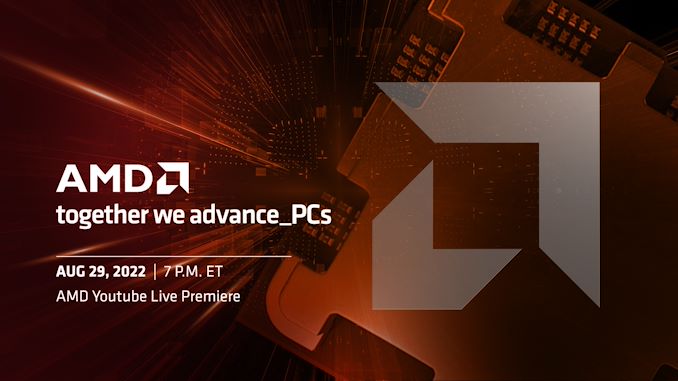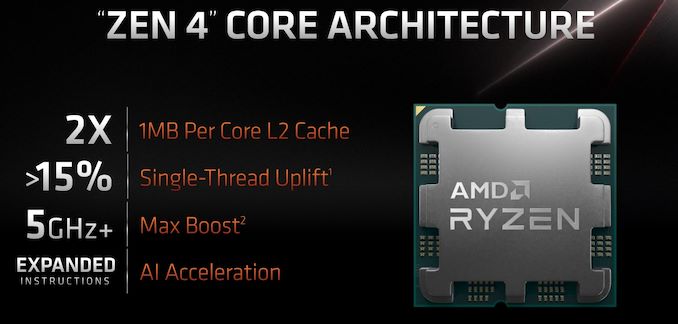AMD Announces Ryzen 7000 Reveal Livestream for August 29th
by Ryan Smith on August 16, 2022 2:25 PM EST- Posted in
- CPUs
- AMD
- Zen 4
- AM5
- Ryzen 7000

In a brief press release sent out this morning, AMD has announced that they will be delivering their eagerly anticipated Ryzen 7000 unveiling later this month as a live stream. In an event dubbed “together we advance_PCs”, AMD will be discussing the forthcoming Ryzen 7000 series processors as well as the underlying Zen 4 architecture and associated AM5 platform – laying the groundwork ahead of AMD’s planned fall launch for the Ryzen 7000 platform. The event is set to kick off on August 29th at 7pm ET (23:00 UTC), with CEO Dr. Lisa Su and CTO Mark Papermaster slated to present.
AMD first unveiled their Ryzen 7000 platform and branding back at Computex 2022, offering quite a few high-level details on the forthcoming consumer processor platform while stating it would be launching in the fall. The new CPU family will feature up to 16 Zen 4 cores using TSMC's optimized 5 nm manufacturing process for the Core Complex Die (CCD), and TSMC’s 6nm process for the I/O Die (IOD). AMD has not disclosed a great deal about the Zen 4 architecture itself, though their Computex presentation has indicated we should expect a several percent increase in IPC, along with a further several percent increase in peak clockspeeds, allowing for a 15%+ increase in single-threaded performance.
The Ryzen 7000 series is also notable for being the first of AMD’s chiplet-based CPUs to integrate a GPU – in this case embedding it in the IOD. The modest GPU allows for AMD’s CPUs to supply their own graphics, eliminating the need for a discrete GPU just to boot a system while, we expect, providing enough performance for basic desktop work.
| AMD Desktop CPU Generations | |||
| AnandTech | Ryzen 7000 (Raphael) |
Ryzen 5000 (Vermeer) |
Ryzen 3000 (Matisse) |
| CPU Architecture | Zen 4 | Zen 3 | Zen 2 |
| CPU Cores | Up To 16C / 32T | Up To 16C / 32T | Up To 16C / 32T |
| GPU Architecture | RDNA2 | N/A | N/A |
| GPU Cores | TBD | N/A | N/A |
| Memory | DDR5 | DDR4 | DDR4 |
| Platform | AM5 | AM4 | AM4 |
| CPU PCIe Lanes | 24x PCIe 5.0 | 24x PCIe 4.0 | 24x PCIe 4.0 |
| Manufacturing Process | CCD: TSMC N5 IOD: TSMC N6 |
CCD: TSMC N7 IOD: GloFo 12nm |
CCD: TSMC N7 IOD: GloFo 12nm |
The new CPU family will also come with a new socket and motherboard platform, which AMD is dubbing AM5. The first significant socket update for AMD in six years will bring with it a slew of changes and new features, including a switch to an LGA-style socket (LGA1718) and support for DDR5 memory. Providing the back-end for AM5 will be AMD’s 600 series chipsets, with AMD set to release both enthusiast and mainstream chipsets. PCIe 5.0 will also be supported by the platform, but in the interest of keeping motherboard prices in check, it is not a mandatory motherboard feature.
The remaining major disclosures that AMD hasn’t made – and which we’re expecting to see at their next event – will be around the Zen 4 architecture itself, as well as information on specific Ryzen 7000 SKUs. Pricing information is likely not in the cards (the industry has developed a strong tendency to announce prices at the last minute), but at the very least we should have an idea of how many cores to expect on the various SKUs, as well as where the official TDPs will land in this generation given AM5’s greater power limits.
Meanwhile, AMD’s press release does not mention whether the presentation will be recorded or live. Like most tech companies, AMD switched to pre-recorded presentations due to the outbreak of COVID-19, which in turn has been paying dividends in the form of breezier and more focused presentations with higher production values. While relatively insignificant in the big picture of things, it will be interesting to see whether AMD is going back to live presentations for consumer product unveils such as this.
In any case, we’ll find out more during AMD’s broadcast. The presentation is slated to air on August 29th at 7pm Eastern, on AMD’s YouTube channel. And of course, be sure to check out AnandTech for a full rundown and analysis of AMD’s announcements.
Source: AMD











52 Comments
View All Comments
NextGen_Gamer - Tuesday, August 16, 2022 - link
With regards to pricing details, there are two rumors for when the CPUs/AM5 platform will actually go on sale. One puts it on Sep 15, the other on Sep 27. If it is Sep 15, then I'm guessing we will hear how much everything will cost. That is only a couple of weeks after the presentation after all, and preorders (if they exist for them) would start even sooner than that.I'm also guessing we will get a “together we advance_Gaming” event sometime in October, or late September, for the RDNA-3 cards :)
meacupla - Tuesday, August 16, 2022 - link
Pricing leak rumour is that 7000 series will be more expensive than a core/thread equivalent 5000 series. But I guess we'll have to see how hard intel punches with 13th gen.Hopefully DDR5 compatibility on 7000 series will be good with faster RAM sticks, as Intel has already shown that DDR5 is very slow outside of 2x16GB sticks on 2 slot mobos.
Still waiting for an announcement of what the 600 series chipset will look like. The last rumour I heard was dual chipset?
erotomania - Tuesday, August 16, 2022 - link
X670E (for Extreme) will be dual chipset for more I/O. X670 and B650 (or whatever the equivalents end up being this gen) will be standard single chipset.James5mith - Tuesday, August 16, 2022 - link
Like a return to old school northbridge/southbridge style designs? What would the second chipset be for in this case? Old school northbridge's were the location of the memory controller in the past. Now all of the northbridge functionality has been absorbed on-die or on-package into the CPU itself.erotomania - Tuesday, August 16, 2022 - link
Today's "Northbridge" is basically a fancy I/O hub, so two of them just increases I/O on the mobo. PCIe mainly, possibly USB and SATA.at_clucks - Thursday, August 18, 2022 - link
Yesterday's southbridge is today's northbridge.erotomania - Tuesday, August 16, 2022 - link
A) Together we advance_PCsB) Together we underscore PCs...in advance.
WaltC - Tuesday, August 16, 2022 - link
You say in the article: "In a brief press release sent out this morning, AMD has announced that they will be delivering their eagerly anticipated Ryzen 7000 unveiling later this month as a live stream.""Live stream" says to me that it's a live event, which will be streamed live, as opposed to per-recorded.
Yet your article near the end says, "Meanwhile, AMD’s press release does not mention whether the presentation will be recorded or live." I mean, doesn't "live stream" kind of give it away?
This is an important release for AMD--not just a refresh, etc. So I imagine the 7:00 pm ET is also due to the live event.
Ryan Smith - Tuesday, August 16, 2022 - link
"Yet your article near the end says, "Meanwhile, AMD’s press release does not mention whether the presentation will be recorded or live." I mean, doesn't "live stream" kind of give it away?"AMD has called previous recordings livestreams as well. If it's broadcast on YouTube and it's not uploaded as a recording (that is, it's in "live" mode and you can't skip ahead to the end), then AMD considers that a livestream.
abufrejoval - Tuesday, August 16, 2022 - link
There don’t seem to be too many secrets left. Some things I’d like to know: any additional features with regards to control flow integrity? Shadow stacks were supported on Zen 3, but the forward branching extensions were missing: have they been added?Any news on per VM memory encryption being carried forward to client CPUs?
I am mostly a bit disappointed by the desktop “chipsets”. Since the Zen 4 CCDs are shared between servers and desktops, they obviously are designed at least for CXL 1.1. And just like the Infinity Fabric that means a lot of flexibility what protocol you speak on which bundles of lanes.
Except that it doesn’t carry forward into the desktop space.
I understand that using half of a full IOD as X570 “chipset” was expensive in terms of power and chip cost, but it was genius in having at least potentially IF between the two IODs. I’d just love to see an extension of this perhaps even with these next-gen IODs talking CXL, too.
There are 7 groups of PCIe 5.0 x4 coming off the SoC and just imagine if these 7 groups were to be slots on a passive backplane. Add-on cards would then have an IOD switch at their base and fan out to say 4-8 M.2 slots, perhaps with a bit of USB strewn in to fill the slot’s bracket. Obviously, it could also be one or several 10/40/100 Gbit NICs or CXL. And CXL includes RAM, accelerators, TPUs, DPUs, you-name-it.
The current ‘solution’ which has one set being dedicated to USB4, another for the ‘South bridge’, daisy chained or not, is just lame! And a complete waste.
In this world of NVMe storage, any networking below 10Gbit/s is just insane. We’ve been crippled by Gbit NICs since the last millennium and this has just got to go! The Aquantia/Marvell ACQ113 has been around for some time now, yet you have to shell out an extra €400 to have that €20 chip included on a mainboard?
This ASmedia daisy chain setup may be extremely cheap and commodity (surely it won’t be sold that way), but it’s utterly wasting the potential of Zen 4 hardware.
AMD has an opportunity to completely redefine the desktop and entry/edge level server market and deliver a level of flexibility and expandability that is dizzying, but it’s letting it slide through their hands. Neither Intel nor ARM can currently match that and it’s one of those once-in-a-lifetime opportunities that won’t come back.
AMD, please wake up and deliver a new entry level mainboard architecture. No need to change AM5 or the SoCs, only a complete revamp of the mainboards will suffice.
You can start by hooking another ASmedia chip to the ‘NVMe’ or ‘USB4’ lane bundles, daisy chain or not. Put those on a slot and you can cool and use them on a tower chassis.